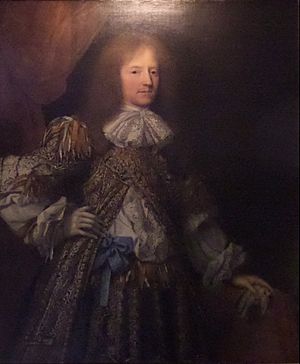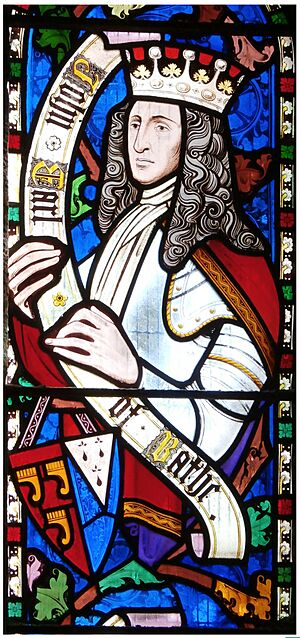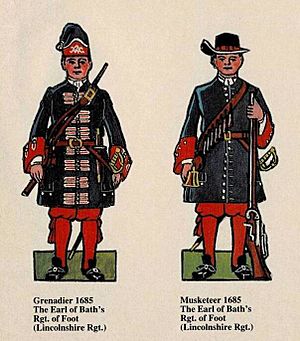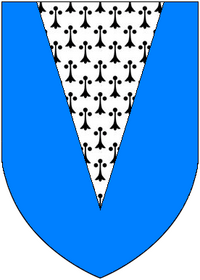John Granville, 1st Earl of Bath facts for kids
Quick facts for kids
John Granville, 1st Earl of Bath
|
|
|---|---|

John Granville, 1st Earl of Bath
|
|
| Lord Lieutenant of Devon | |
| In office December 1685 – April 1696 |
|
| Lord Warden of the Stannaries | |
| In office October 1660 – August 1701 |
|
| Lord Lieutenant of Cornwall | |
| In office October 1660 – May 1696 |
|
| Governor of the Scilly Isles | |
| In office 1649–1651 |
|
| Personal details | |
| Born |
John Grenville
29 August 1628 Kilkhampton, Cornwall |
| Died | 22 August 1701 (aged 72) St James's, London |
| Resting place | St James' church, Kilkhampton |
| Nationality | English |
| Spouse | Jane Wyche (1652–1692) |
| Children | Jane (c. 1653 – 1696); Charles (1661–1701); John (1665–1707); Catherine (1666–?); Grace (1667–1744) |
| Parents | Sir Bevil Grenville (father); Grace Smythe (mother) |
| Occupation | Soldier, landowner and courtier |
| Military service | |
| Rank | Colonel |
| Battles/wars | Wars of the Three Kingdoms Lostwithiel; Second Newbury; Torrington; |
John Granville, 1st Earl of Bath (born August 29, 1628 – died August 22, 1701) was an important English nobleman. He was a soldier who fought for the King during the English Civil War. After the King returned to power in 1660, John Granville was given a special title and many important jobs.
Contents
About John Granville
John Granville was born on August 29, 1628, in a place called Kilkhampton in Cornwall, England. He was the third son of Sir Bevil Grenville and Grace Smythe.
His aunt, Elizabeth Smythe, was the mother of George Monck, 1st Duke of Albemarle. George Monck was a very important person who helped bring King Charles II back to the throne in 1660. This family connection later helped John Granville become an Earl.
John was one of thirteen children. Sadly, his two older brothers died young. This meant that when his father, Sir Bevil, died in battle in 1643, John became the heir to his family's large estates.
His Life and Work
John Granville was a soldier during the Wars of the Three Kingdoms (1638 to 1651). He fought in a special army unit that his father had created for King Charles I. In 1643, after a battle in Bristol, he was made a knight.
He became a "Gentleman of the Bedchamber" for the future King Charles II. This meant he was a close helper to the King and went with him when the King had to leave England.
In 1648, King Charles II made him the Governor of the Scilly Isles. These islands were important because they were used by Royalist ships to attack English and Dutch ships. This helped the King's side get money. In 1651, John Granville was captured when Parliament's forces took back the islands.
After he was set free, John Granville stayed in England. He kept working secretly to help the King. In 1660, he played a key role in talks between King Charles II and his relative, George Monck. These talks led to the King returning to power, an event known as the Stuart Restoration.
John Granville hoped to become a Duke, but that title went to George Monck. Instead, in 1661, John was given the titles of Baron Granville, Viscount Granville, and Earl of Bath. He also became a Privy Councillor in 1663, which meant he was a trusted advisor to the King.
In 1665, he was named Lord Lieutenant of Ireland, but he never actually went there. He spent a lot of time and money rebuilding his family home, Stowe House, in Cornwall. This house was very grand, but it was taken apart in 1739. Some parts of it can still be seen today in the Guildhall in South Molton, Devon.
John Granville also signed a document in 1667 that helped create the Royal African Company. This company was involved in trade. He was good friends with the leader of this company, who was the Duke of York (and later King James II).
Under King James II, John Granville was a colonel in a special army unit called the Earl of Bath's Regiment. He served during the Monmouth Rebellion in 1685 and again in 1688. During the Glorious Revolution in November 1688, he was in charge of the important ports of Exeter and Plymouth. He then decided to support William III.
Because of his support, he was made Lord Lieutenant of Devon. However, he still didn't get the title of Duke of Albemarle, and a legal fight over the Albemarle family's money almost made him bankrupt. Just two weeks after John Granville died in August 1701, his son Charles also passed away.
Family Life
In October 1652, John Granville married Jane Wyche in Kilkhampton. Jane was the daughter of Sir Peter Wyche, who was an English ambassador. John and Jane had five children together.
His Sons
- Charles Granville, 2nd Earl of Bath (1661-1701): He was the oldest son and inherited his father's titles. Sadly, he died while his father's funeral was being planned. Charles was married twice. He had one son with his second wife:
- William Henry Granville, 3rd Earl of Bath (1692–1711): He died at age 19 from smallpox and had no children. After his death, the title of Earl of Bath ended.
- John Granville, 1st Baron Granville of Potheridge (1665–1707): He was given the estate of Potheridge in Devon. This was the old home of the Monck family.
His Daughters
- Lady Jane Granville (died 1696): She married Sir William Leveson-Gower, 4th Baronet. Her descendants later shared in the inheritance of the 3rd Earl of Bath.
- Lady Catherine Granville: She married Craven Peyton. They did not have any children.
- Lady Grace Granville (1654–1744): She was given her own title, 1st Countess Granville. She married George Carteret, 1st Baron Carteret. Her children and their families also shared in the inheritance of the 3rd Earl of Bath.
Death
John Granville died in London in 1701, just before his 73rd birthday.
Family Symbols (Armorials)
The family symbol, or "armorials," of the Granville family has a unique design. It looks like musical pipes or a wind instrument. Some people have called these symbols "clarions" (a type of trumpet) or "rests" (like a place to hold a lance). The Latin motto beneath the symbol means "The future is unseen."
Images for kids







